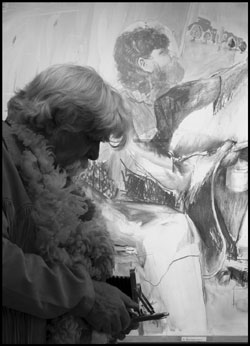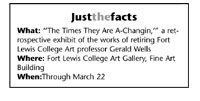| ||||||
The Times They Are A-Changin’
by Jules Masterjohn "The Times They Are A-Changin’” is an appropriate title for the retrospective exhibit by artist Gerald Wells currently on display at the Art Gallery at Fort Lewis College. Wells, a professor of art at Fort Lewis since 1970, is retiring from teaching. The last of the “old guard” art faculty, he has seen much change within the college, the culture and himself over the last 35 years. As one enters the gallery, a portrait of Bob Dylan hangs next to an old Polaroid land camera. A photo-collage of Wells’ invented character, Burley Wisehart, completes the scene. Interspersed with paintings from the Burley Wisehart series are computer-generated images of otherworldly places. This juxtaposition of media and subject matter sets the stage for the world according to Wells. As a young man during the ’60s and ’70s, Wells’ view of the world was radicalized by his encounters with forward thinking individuals like writers William Faulkner and Edward Abbey; avant-garde filmmaker Stan Brakhage; and minimalist artist Angelo di Benedetto. The social unrest of the era also had an impact. A particularly “enlightening” event took place when he was in college at Ole Miss, the University of Mississippi in Oxford, Miss. His printmaking instructor was arrested and jailed for using an image of the Mississippi state flag in a piece of art that was considered, by the powers that be, unpatriotic. This event helped form Wells’ ideas of the role of art and freedom of expression. After receiving his B.A. and M.F.A. in printmaking from Ole Miss, Wells pursued his teaching career, following it to Kentucky, Wisconsin and North Carolina. During his appointment at Western Carolina University, Wells shared an art studio with another professor, who was a close friend of Edward Abbey. It was through Abbey that Wells was introduced to Durango. Wells’ first trip to Colorado came on the invitation of artist Angelo di Benedetto, who needed tutoring on the use of his new printing press, with which Wells was familiar. During this visit, Wells found creative kinship with a small cadre of intellectuals who gathered at di Benedetto’s converted warehouse in Central City. Wells remembers these soirees as involving “wine, conversation and an unruly assortment of long hairs.” This gathering of minds recurred each summer, for years to come, while Wells was in Vail, directing the summer arts program for the Vail School of Fine Arts. From there, he accepted a teaching position at Fort Lewis College. During his tenure, he has headed up the disciplines of printmaking and photography as well as taught classes in drawing and design. He established the college’s well-equipped printmaking studio and, seeing the changing times within the visual art world, developed the computer graphics program.
Wells was department chairman during the design and construction of the new Fine Art Building and initiated the department’s first visiting-artist program. As an artist, he has mounted more than 40 one-person exhibitions of painting, prints, drawings and digital images, and he has won prizes on state and national levels for his work. The major body of work that has consumed 20 years of Wells’ creative activity is the Burley Wisehart series. These paintings document the imaginary antics of his character, Burley, who represents the aspect of the artist’s own psyche that was naïve and unskilled in human interactions. Wells substantiates this representation by creating the storyline that “Burley was raised by blue tick hounds in a Mississippi swampland.” The artist also created the antithesis of Burley, in Burley’s brother, Bulk Wisehart. Bulk embodies everything that Wells has found wrong with the changing world. A developer, televangelist and politician, Bulk’s pig-like face is pictured salivating with desire, his stuffed belly unattractively thrust toward the viewer as if to say, “I will consume you, too, if you get in my way.” While Bulk symbolizes greed and corruption within society, Burley portrays goodness, though his actions are clueless and socially inept. In his series of mixed-media paintings dating from the 1970s through 1991, Wells portrayed adventures in which his protagonist, Burley (always depicted with a silk-screened photographic portrait of Wells’ face), confronts an insidious world. In “Burley Wisehart and Charles Bronson Having Tea Before Wiping Out a Few Hundred Business-types,” Wells plays out his fantasy of ridding the world of ever-growing corporate control. Wisehart and Bronson seem so sure of victory, they casually sip tea as a crowd of black-suited men approach. Pictured in other paintings from the series are images of Evil Knievil’s motorcycle, Jean-luc Picard and Bob Dylan. Speaking of his Burley Wishart series, Wells admits, “Almost all my representational images are about my personal anger at the decaying human condition and have nothing whatever to do with art – since art is always about the best achievements of the few in any field who strive to produce the ‘next thing,’ which is, of course, innovative and therefore unfamiliar.” For Wells, the “next thing” involves his exploration and use of the advanced technology that computers provide. He is excited to “push the computer to do things it cannot, to pit the program against itself” in an attempt to create imagery that is unique. He writes in his exhibition statement, “This new technology has become a friend, which has challenged me to revisit the teachings of a few art philosophies from my past in ways that allow me to more deeply understand the physics and quantum ontologies underlying imagery.” If the Burley Wisehart series displays his anger, these new images show us Wells’ thought processes. The computer-generated images, printed on archival paper, are titled “Wedding of Fractals,” “Avatar” and “Mothership,” to name a few. The crisp, clean compositions are emotionally cool, devoid of the raw directness found in Wells’ mixed-media paintings. In many of his new works, Wells has created worlds far from the tyranny of greed and materialism that plague our own: these new places are ruled by logic and mathematics, unsullied by human desires. In a few pieces, photographic images of recognizable landscapes place the viewer on the Earth, yet a warped portal to another dimension is also apparent. Perhaps by using the computer to create imaginary places where the visible boundaries between matter and energy dissolve, Wells has found true creative potential. The computer generated works are sublime, possessing the ability to move one’s mind beyond the recognizable, past the confines of the physical plane, to experience other states of being. •
|
In this week's issue...
- May 15, 2025
- End of the trail
Despite tariff pause, Colorado bike company can’t hang on through supply chain chaos
- May 8, 2025
- Shared pain
Dismal trend highlights need to cut usage in Upper Basin, too
- April 24, 2025
- A tale of two bills
Nuclear gets all the hype, but optimizing infrastructure will have bigger impact




